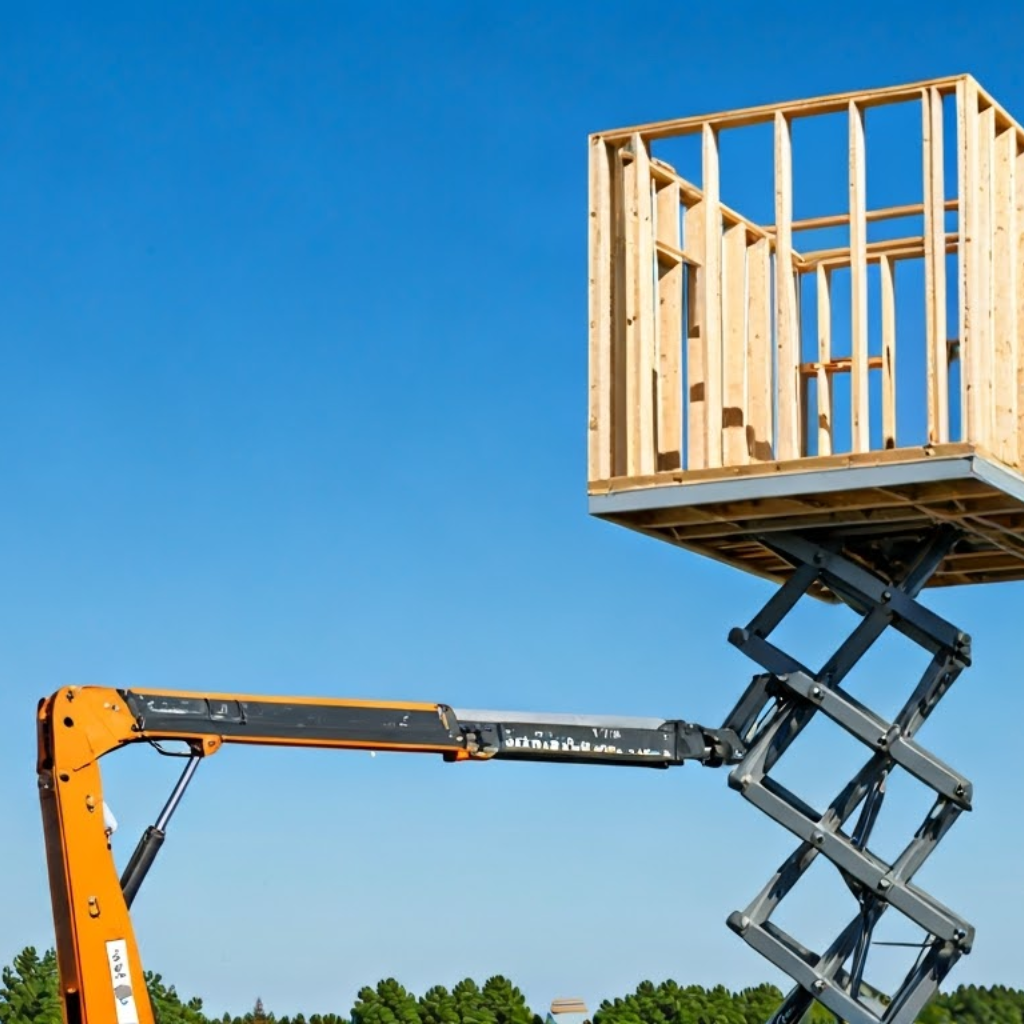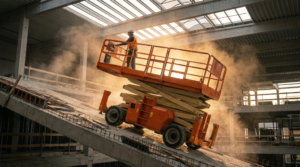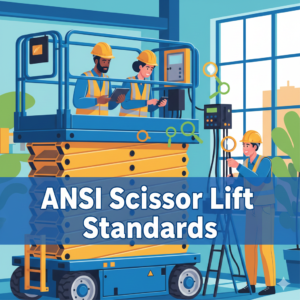The right choice of the rough terrain scissor lift can make the difference between a smoothly running project and a project that is full of costly setbacks.
You can hire a professional to help you select if you are not confident in the matter but finding the right one gives you at least the knowledge you need to look for.
You can implement it when you are managing outdoor construction jobs or dealing with challenging maintenance works i.e., the awareness of the key factors.
Usually, it is quite normal for those of you who are inexperienced in this area, to feel confused about the selection process so that is why we have come up with a list of the most important equipment rental issues that, in our opinion, will greatly affect your project outcome:
- The scissor lift height and the reach necessary
- Land adaptability on rough terrain
- The machine’s safety features
- The load capacity and the size of the platform
- Problems arising only from specific points
If we break them down, these basic aspects are the necessary sections which will enable you to decide on the perfect rough terrain scissor lift for your special case.
At the end of the guide, you will be capable of making a decision on the rental which is the safest and most effective at the same time.
Key Points to Remember:
- It is necessary to match the lift height with the working height of your project and the safety and efficiency point of the work area if you want to get the project done at all times safely and also on time every time.
- Terrain adaptability is most important when the outdoor usage of the machine is under consideration because of uneven surfaces – besides wheel drive systems, other parts of the lift like the hydraulic stabilizers are also required to perform better.
- The load capacity and also the platform size must be considered very carefully because the scissor lift at the same time should ensure your team, tools, and material will be safely transported and you can use the necessary facilities.
- Aerial work platform safety features, such as manual lowering valves and dual lanyard attachments, must be checked in order to provide workers’ protection.
- Factors which are related to the site such as ground conditions, space constraints, and the environment will always be the main factors determining the decision to rent a rough terrain scissor lift.
Most scissor lift models come with the incorporation of a powerful 4-wheel drive system which makes it possible to have steady traction on any kind of ground condition.
The extra large snake-bite tires are designed to provide unrivaled grip on the surfaces made of loose soil, gravel, and mud while the swivel axle affirms the right strength between ground and vehicle on irregular terrains.
The pairing of a high power-to-weight ratio with modern traction systems allows the scissor lifts to travel over rough terrains without compromising stability.
This ensures a wider scope of outdoor applications for the machines compared to traditional lifts that would be otherwise inefficient in these terrains.
💡 Key Takeaway: 4-wheel drive ground clearance and advanced hydraulic stabilizers have together formed heutonym transfer, supported by the superior ground clearance as a result of the above-mentioned performance which ensures the lifts drive over obstacles and slopes in a stable way.
Power and Performance Summary
Battery and Power Options
It is of utmost importance that you are aware of the power specifications when choosing a rough terrain scissor lift, as it is the only way to guarantee the continuity of the efficient performance of your project. Modern rough terrain scissor lifts come fitted with powerful motor systems that have been tested and proven in rugged off-road scenarios where assurance of performance is vital to the users.
Most rough terrain scissor lifts are set-up to be highly flexible and they are characterized by two types of power sources – diesel for outdoor and electric for indoor. Almost all users regard the units to be the best due to the high torque the diesel engine provides coupled with almost as fast lift speed and this is typically an outcome of the tough construction sites and rough terrains.
The electrically powered models not only boast of a noiseless operation but also do not arouse emissions, a good fit for indoor work and green spaces. Most of these types appear to use a deep-cycle battery that can cover a day’s duty in a single charge. The battery packs are made in such a way that they could be intact even when encountering severe vibrations and impacts in rough terrain applications.
Hybrid power is the power of choice in some of these models to ensure that the machines are capable of facing any given situation by maximizing the potential of both electric and diesel. The feature enables operators to change from one source of power to another, flexible for working conditions and project requirements.
The main focus of the hydraulic systems on these lifts is the provision of smooth, controlled operation, even when carrying heavy loads. An advanced power management system is in place to achieve the best energy utilization by helping the equipment stay on while still maintaining the same performance levels at the start.
💡 Key Takeaway: Today’s rough terrain scissor lifts, equipped for the future, come with flexible energy sources, from diesel to electric and hybrid systems, thus, ensuring the continued adaptability and efficient running of various projects in different environments all the while reducing carbon emissions.
Final Share
Choosing the right tough terrain scissor lift may affect project success and safety. You may achieve efficiency and performance in each project by carefully considering height requirements, terrain adaptability, platform size, environmental stability characteristics, load capacity, and site-specific considerations.
However, every project has its unique issues, so knowing these fundamental considerations can help you make the best option. To make an educated choice regarding renting this equipment and its effect, consider working height, platform size, and climate. A well-chosen scissor lift will boost productivity and team safety.
FAQs
Ready to select the right difficult terrain scissor lift for the job?
Our skilled specialists are available for customized advice and affordable prices. We can assist you find the right equipment for your application while prioritizing safety and efficiency.
What is the typical rental duration for a rough terrain scissor lift?
Most rental companies are very flexible that they offer rentals not less than 24 hours and up to the entire month. It all depends on the completion time of the project and the budget. For example, hourly rentals are the best solution for quick tasks, whereas weekly or monthly rentals make more sense in case of long-term projects.
How much training is required to operate a rough terrain scissor lift?
Operators must be trained and certified according to OSHA standards before they are allowed to operate any aerial work platform. The training generally includes both theoretical lectures and practical exercises and thus teaches the workers all the necessary safety rules and procedures as well as the necessary steps for the occurrence of an emergency.
Can rough terrain scissor lifts be used in windy conditions?
The machines are suitable for outdoor working, but they are strictly designed for a certain range of wind speeds during operation. Most of the types can be safe under winds up to 28 miles per hour but always remember to be interested in what the manufacturer recommends and use at least hydraulic stabilizers for additional safety.
What maintenance is required during the rental period?
On a daily basis, the hydraulic oil must be checked, and the condition of the tires must be inspected. Through the use of a simple examination, drivers begin by ensuring that the platform is in good condition and follow the confirmation by checking out the emergency controls, as well as the safety features of the machine, which has to be functioning well before selling out.
How do I determine the right platform size for my project?
The choice of the platform size should depend on the number of workers, the amount of tools, and the kind of materials that are to be used on the platform simultaneously. Medium-sized platforms that are approximately 5’x 13′ to 6’x24′ feet can handle most of the jobs, but there are also high and narrow width models for constricted spaces.
Which power sources can be used to operate rough terrain scissor lifts?
Typically, the majority of the available models are equipped with diesel motors for outdoor work. They very often come with lithium battery-powered systems, so that they can be used in a quiet mode. There are also dual-fuel alternatives that use gas and propane separately or in combination, thus, allowing users to work basically in any location.





